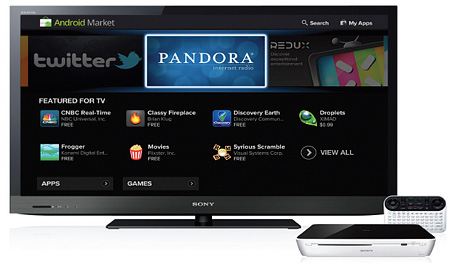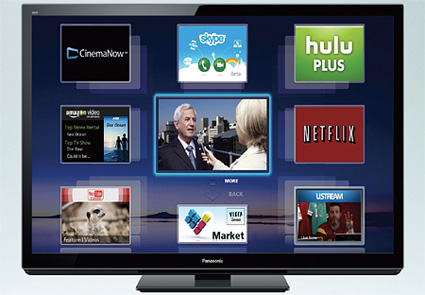TV Connects for the Holidays
ALEXANDRIA, VA.—As DTV set makers and retailers slip cautiously into the all-important holiday sales season amid some surprisingly positive forecasts, HDTV shoppers will find it hard to escape the core message that Connected TVs offer something new that most current HDTV owners don't yet enjoy.
Following in the confident footsteps of today's tablets and smartphones, new Connected TVs will be coming with factory-installed apps for TV content providers well beyond traditional broadcast and cable—i.e., Netflix, Facebook, Twitter, Flicker, Hulu Plus, Amazon, Skype Video, and even Pandora Internet Radio. And despite the perception that the buzz on 3DTV appears to have died away, several set makers will continue to push the format—especially with their high-end Connected TV models.

Sony’s connected TV platform is powered by Google TV. Nevertheless, with large-screen HDTV, DVRs, and Blu-ray players firmly established in the consumer mindset, it will be Connected TV in the weeks to come that will be heralded by manufacturers' advertising as the next logical step in DTV's progression. Globally, more than a quarter of all DTVs shipped in 2011 will be connectible, according to new data from researcher DisplaySearch, and that's projected to jump to 54 percent by 2015—mostly concentrated in Japan, Western Europe, and North America.
SUCCESSFUL 'FAILURE'?
Despite a shaky economy, consumer spending on all electronics this holiday is projected to reach an "all-time high," according to the Consumer Electronics Association's "Annual CE Holiday Purchase Patterns Study." The "TV/any type" category ranks on consumer wish lists near the middle among all electronics (after tablets, notebooks and laptops). "Connected TV is becoming a rapidly distributed feature across virtually all manufacturing lines and size segments," said CEA Industry Analysis Director Steve Koenig. "These days, [TV] consumers are looking for value—and all that connectivity and convenience over the Internet translates into value."
In terms of product promotion, Koenig said, "Connected TV this season will be pretty congruent with what it's been for the past year or so. But chances are anyone buying a new TV this holiday is going to get a connected set anyway—whether they're really looking for one or not—because it's a standard feature on a lot of sets now."
That's a key point also made by Principal Analyst James McQuivey at Forrester Research. "TV sales are on autopilot," he said. "A certain number of people will need a new TV this holiday season and so they'll find that the TV they most want to buy, based on size and price, is also a Connected TV. So quite according to plan, the industry will successfully place more Connected TVs inside consumers' homes—but without instilling any passion in those consumers."
As a result, McQuivey says, this passionless component will result in the continuation of a persistent dilemma: "As many as half these new buyers will not bother to 'connect' their TV—and among those who do, a significant number won't bother to use it much after connecting it. This is why I call Connected TV the most 'successful failure' in consumer electronics history," McQuivey said.
MIXED SALES PICTURE

Panasonic’s Viera-brand connected TV sets Still, manufacturers themselves see more intrinsic value in the allure of Connected TV itself—albeit coming at the same time several of them are reeling from economic downturns. Sony Corp., for example, projects it will finish this calendar year $1.15 billion in the red (although Sony Pictures in Hollywood could show a profit of more than $265 million).
Brian Siegel vice president of TV for Sony Electronics Home Division said in addition to connectivity capabilities on several of its Blu-ray players (a technology which Sony developed), "More consumers are streaming content to their television [sets] every day, and it's growing incredibly quickly," he said. "We expect consumers will be streaming more than half the content they view by 2019—thus, actually watching more streaming content than traditional TV broadcasts."
Sony's Internet TV platform is powered by Google TV which released version 2.0 last month. By "Black Friday," (Nov. 25), four-in-five new sets in Sony's TV line will be Internet-connectable, according to Siegel. And unlike some in the industry, Sony continues to see a bright future for 3D, which it's including in all its higher-end Connected TV models. "All Sony 3D televisions also feature full Internet connectivity, so it's not an either/or proposition for the consumer," Siegel said.
Panasonic, looking at its own net loss in 2011 of $5.5 billion, also said its Viera-brand Connected TV—with and without 3D—will be showcased in the crucial weeks ahead. Jim Sanduski, Panasonic's senior vice president for sales, said 90 percent of his plasma line (42-65 inches) and 65 percent of his LCD units (42 inches and smaller) contain some form of connectivity. "It's a big initiative. We see a lot of appeal to our customers," Sanduski said. Some of Panasonic's Blu-ray players also have connectivity options, and it hopes to sell as many as 3.5 million connected sets with 3D in the U.S. this year. "This [holiday] will represent a quantum leap in connected availability. Right now our most popular app is Netflix," Sanduski said.
Vizio, the top-selling U.S. set maker in 2010, and Samsung, chose not to comment on their holiday plans. At LG Electronics, Toyota was signed in early November as its first advertising sponsor for its "Smart TV" connectivity platform. The ad technology, made possible via a deal between LG and YuMe, will enable the carmaker to promote its 2012 Camry models.
Matthew Durgin, LG's director of Smart TV Content, said their approach to Connect TV this season is simple: "Seamless connectivity and intuitive access to limitless content. It's a feature that's now heavily discussed in the retail environment, so maximizing that message is a key success factor."
And as with all holiday consumer electronics sales, the picture will change rapidly when a whole new generation of connected products are expected to debut at the International CES in early January.
Get the TV Tech Newsletter
The professional video industry's #1 source for news, trends and product and tech information. Sign up below.
